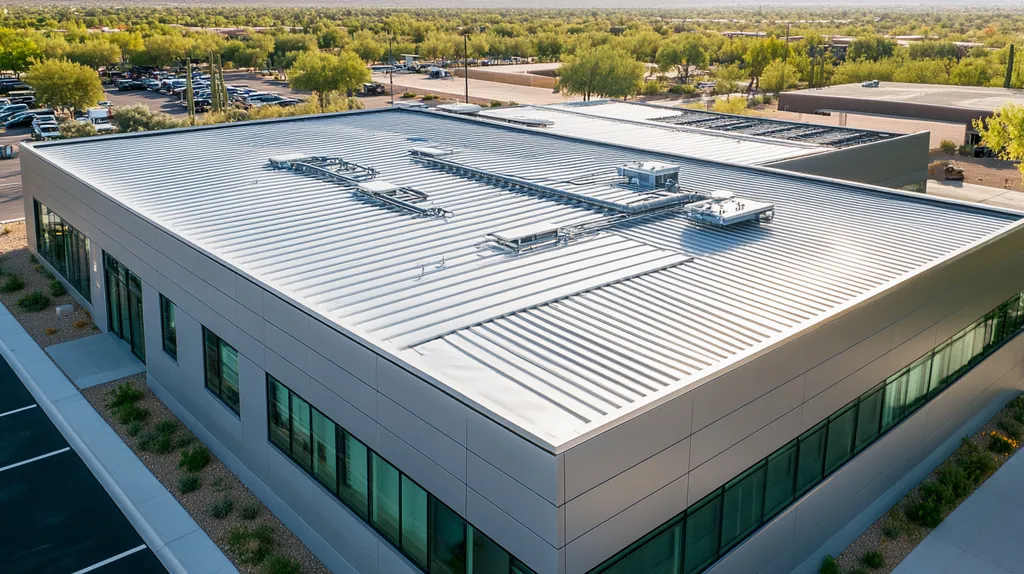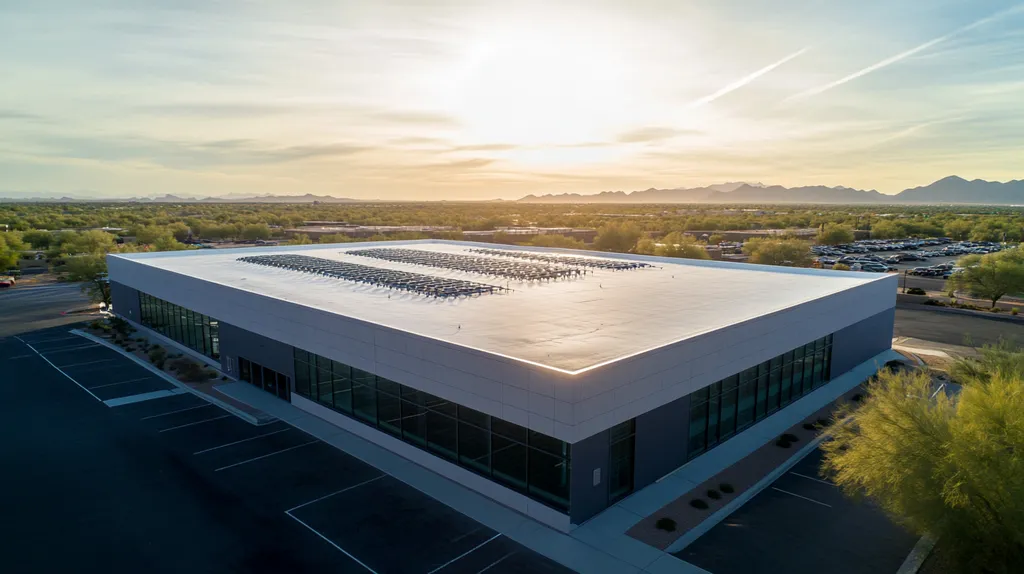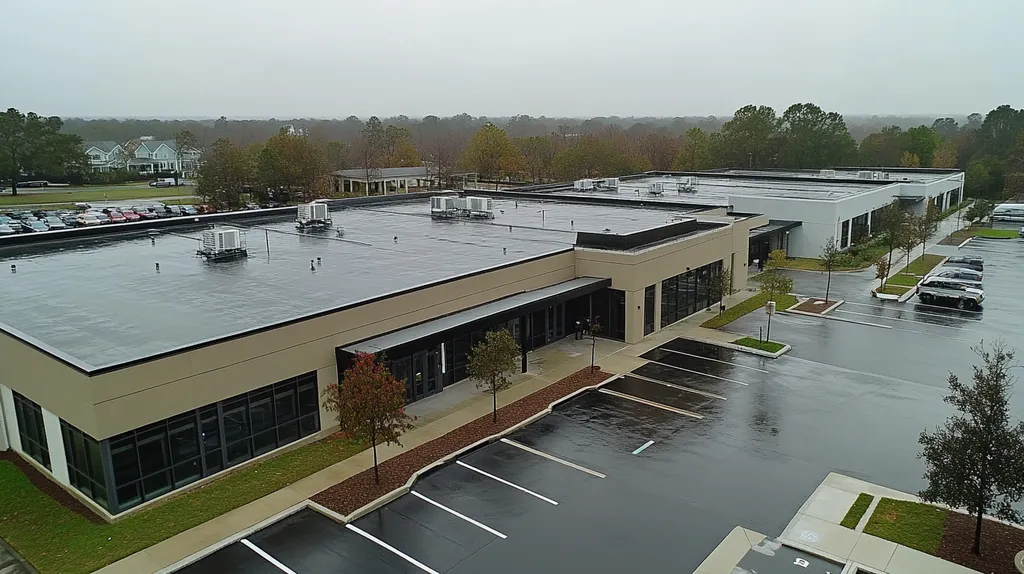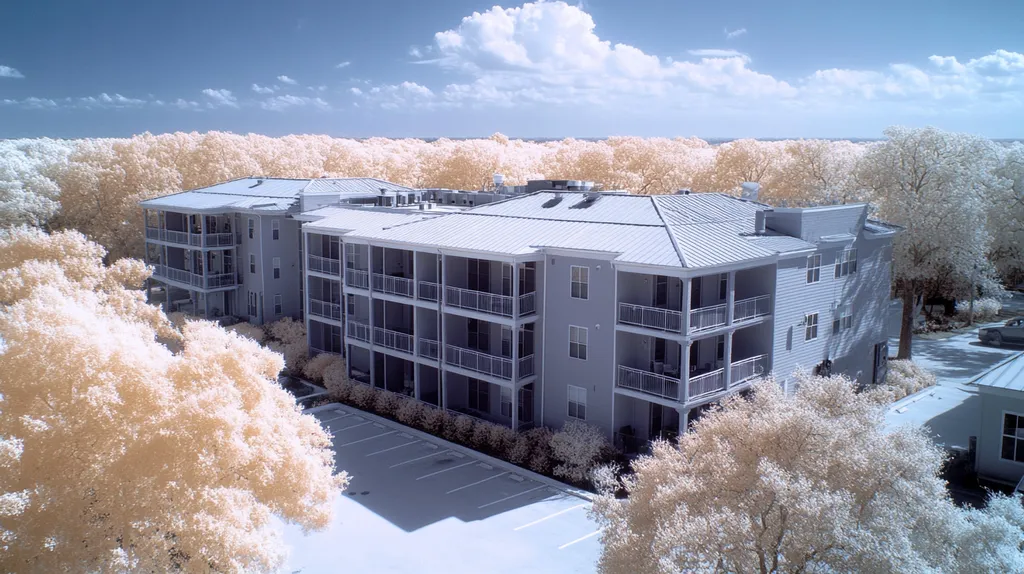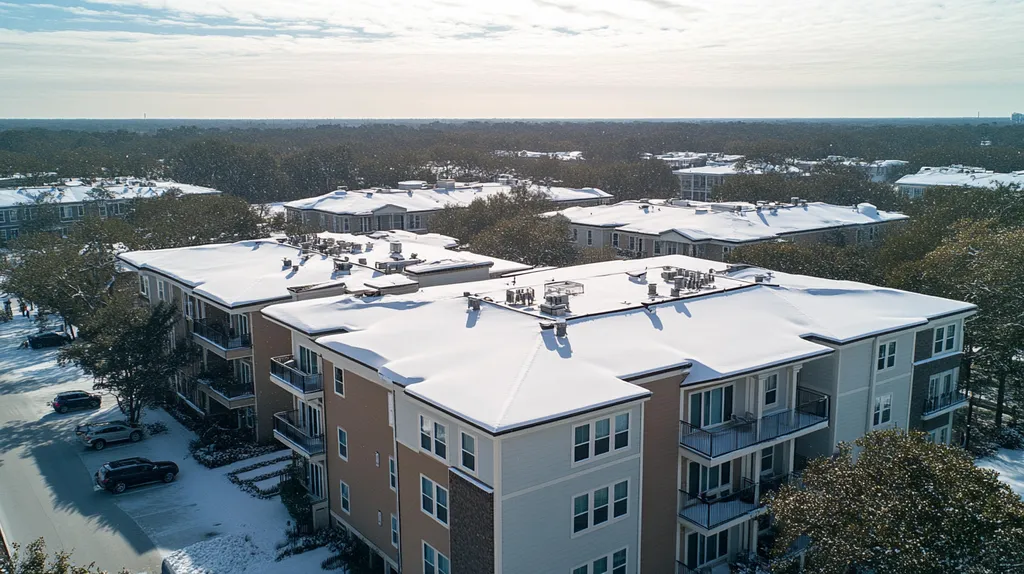In commercial roofing, warranty disputes cost property owners over $1 billion annually in denied claims and unexpected repairs. Without proper warranty coverage and documentation, a single roof failure can lead to hundreds of thousands in damages.
For facility managers and property owners, understanding the complex landscape of commercial roof warranties has become essential for protecting their investments. From manufacturer guarantees to contractor workmanship coverage, each warranty type serves a distinct purpose in safeguarding roofing assets.
This comprehensive guide examines the critical components of commercial roof warranties, implementation requirements, and strategies for optimizing coverage to maximize protection and minimize risk.
SECTION 1: FUNDAMENTAL CONCEPTS
For property owners and facility managers, understanding commercial roof warranties is not just beneficial—it’s essential. With costs soaring between $10,000 and $100,000 for a new roof, a comprehensive warranty can significantly reduce future expenses. Without one, businesses may face unexpected repair costs and risks of asset destruction. This section will break down the types of warranties available, differentiate between manufacturer and contractor warranties, and clarify exactly what warranty coverage entails.
Types of Commercial Roof Warranties
Commercial roof warranties typically fall into two main categories: material warranties and workmanship warranties. Material warranties cover defects in roofing materials and ensure the roof performs as intended. These warranties generally last between 10 and 30 years, depending on the manufacturer and type of material.
Workmanship warranties, by contrast, focus on the quality of installation. They safeguard against issues resulting from improper installation, usually lasting from 1 to 10 years. Having a solid workmanship warranty is crucial for ensuring long-term roof performance.
It’s vital to closely examine the details of each warranty type. Some warranties provide a combination of material and workmanship coverage, offering more comprehensive protection. By understanding these distinctions, property owners can select the best warranty option to meet their specific needs.
In the end, making the right warranty choice helps secure peace of mind and financial protection should roofing issues arise.
Manufacturer vs. Contractor Warranties
Warranties typically come from two key sources: manufacturers and contractors. Manufacturer warranties assure the roof’s materials will perform satisfactorily over time, while contractor warranties focus on the quality of the installation. Grasping the differences between these warranties is crucial for effective risk management.
Manufacturer warranties can often be more comprehensive, covering both material defects and certain installation issues. However, they frequently have specific conditions that must be adhered to, like routine maintenance or inspections.
On the other hand, contractor warranties may be shorter but provide a personalized assurance of quality workmanship. While some contractors offer limited lifetime warranties, it’s important to research their reputation and history to ensure reliability.
When determining whether to choose a manufacturer or contractor warranty, consider the roofing system and specific project needs. Making an informed choice can minimize risks and promote the roof’s longevity.
Understanding Warranty Coverage
A comprehensive understanding of warranty coverage is essential for property owners. Typically, warranty coverage encompasses specified defects, costs for repairs due to material failure, and, in some cases, labor expenses. However, the exact terms can differ widely.
Equally crucial are the exclusions. Common exclusions may include damage from natural disasters, neglect, or insufficient maintenance. Being aware of these exclusions helps prevent unexpected financial burdens in the future.
Additionally, some warranties might require regular maintenance checks to remain valid. Property owners must be proactive in scheduling these inspections to avoid potential loss of coverage.
Ultimately, grasping the intricacies of warranty coverage ensures property owners are well-protected and can effectively navigate the complexities inherent in roofing contracts.
SECTION 2: SYSTEM COMPONENTS
For commercial property owners and facility managers, grasping the components of roofing systems is not just about materials—it’s about safeguarding their investment. Warranties tied to these components can protect against significant losses, given that improper installation could reduce roof lifespan by as much as 25%. This section outlines three essential components of roofing warranties: materials and product warranties, labor and workmanship warranties, and integrated system warranties. Understanding these elements equips property managers to make informed decisions that will enhance roof durability and minimize future costs.
Materials and Product Warranties
Materials and product warranties provide coverage for the physical components of the roofing system. These warranties ensure that the materials perform as expected over time. For example, a high-quality single-ply membrane might come with a warranty lasting up to 30 years, specifically protecting against leaks and performance failures.
The specifics of these warranties can vary widely, so a careful review of the terms is necessary to understand what’s included and what limitations might apply. Failing to address material quality can lead to costly repairs down the line.
Manufacturers often mandate certain installation procedures to keep the warranty valid. It’s crucial to hire a qualified contractor, as using inferior materials or incorrect installation methods could void warranty protection entirely.
Furthermore, warranties can vary in how they cover different potential defects, such as manufacturing errors. Knowing the warranty’s details can be vital for long-term planning and effective budgeting.
Labor and Workmanship Warranties
Labor and workmanship warranties emphasize the quality of installation, which is essential since improper installation is one of the main reasons roofing systems fail. A reputable contractor will typically offer a labor warranty that spans from one to ten years.
Property owners often forget to ask about workmanship warranties, but this oversight can be detrimental. A poorly executed installation can lead to premature roof failure, resulting in avoidable expenses for repairs or even a complete roof replacement.
Reviewing the specifics of the contractor’s warranty is key, as they often require property owners to meet certain conditions—such as routine maintenance and inspections—for the warranty to remain in effect.
For facilities in areas prone to severe weather, an extensive labor warranty can provide much-needed reassurance. Understanding the terms of this warranty can shield property owners from unexpected financial burdens caused by installation errors.
Integrated System Warranties
Integrated system warranties comprehensively cover the entire roofing system, tying together both materials and workmanship. These all-encompassing warranties offer an added layer of protection, ensuring that all components are designed to work cohesively.
With an integrated system warranty, manufacturers guarantee not only the quality of their products but also the installation methods used. For instance, a manufacturer-backed 20-year integrated warranty might cover labor, defects in materials, and failures of components when installed correctly.
The major advantage of this warranty type is clarity in responsibility. Should any issues arise, property owners know who to contact for resolution, minimizing confusion and the potential for delays during emergencies.
However, it’s imperative to confirm that the contractor performing the installation is approved by the manufacturer. If a non-certified contractor is used, the entire integrated warranty could be jeopardized. Thus, thorough research is crucial in selecting the right roofing professionals.
SECTION 3: IMPLEMENTATION METHODS
Failing to comply with warranty requirements for commercial roofing can have serious financial implications. In fact, over 30% of roof replacements are attributed to disputes surrounding warranties. It is crucial for property owners and facility managers to familiarize themselves with the necessary implementation methods. This section highlights key elements such as proper installation techniques, contractor qualifications, and essential inspection procedures.
Installation Requirements for Warranty Validity
Adherence to installation practices is critical for ensuring the validity of roofing warranties. Manufacturers specify exact installation techniques to secure the roof’s longevity and effectiveness. For instance, when installing a single-ply membrane, it’s essential to follow guidelines regarding seam overlaps and adhesion methods strictly.
Ignoring these guidelines can lead to immediate voiding of the warranty. An incorrectly installed roof places property owners at risk for hefty repair costs stemming from leaks and other failures. Thus, it is imperative to closely inspect the installation specifications detailed in the warranty documentation.
Property managers should regularly engage with their roofing contractors to confirm compliance with these installation protocols. Keeping meticulous records of the installation process can facilitate warranty claims should any issues arise. Moreover, proper documentation can significantly smooth the claims process for unexpected damages.
Ultimately, neglecting installation requirements jeopardizes warranty coverage and exposes properties to unnecessary risks. Adhering to manufacturer guidelines is essential for ensuring roofs reach their intended lifespan.
Contractor Certification and Licensing
Selecting a certified and licensed roofing contractor is essential for compliance with warranty terms. Many manufacturers have specific criteria that contractors must meet to qualify as authorized installers. For example, a contractor may need to undergo specialized training to install certain roofing products.
Engaging unqualified contractors can lead to improper installation and may invalidate the warranty. Research indicates that roofs installed by non-certified contractors fail at a rate 50% higher than those handled by licensed professionals. This statistic underscores the critical importance of contractor selection in the warranty landscape.
Property owners should always obtain proof of certifications and licensing before commencing any roofing work. Working with reputable contractors not only strengthens warranty protection but also enhances overall roof performance. Checking online reviews and industry ratings can significantly aid in the contractor selection process.
In conclusion, the significance of contractor certification cannot be overstated. Properly qualified contractors play a pivotal role in both the longevity and warranty compliance of commercial roofing systems, ensuring the protection of valuable investments.
Inspection and Compliance Procedures
Regular inspections are essential for maintaining compliance with warranty conditions and preserving roof integrity. Most manufacturers mandate annual inspections or assessments following significant weather events as part of their warranty terms. Neglecting these inspections may complicate warranty claims later.
For instance, if a roof is damaged in a storm, evidence of recent inspections may be needed to validate the warranty. Without this documentation, warranty claims could be denied, leaving property owners with hefty repair bills. This highlights the necessity of proactive compliance measures.
Property owners should establish a routine for regular inspections, ensuring that all findings and repairs are thoroughly documented. This not only supports compliance but also helps identify potential problems before they escalate. Engaging qualified inspectors familiar with specific roof types and warranty conditions can provide valuable insights.
Additionally, creating a checklist of compliance procedures can streamline the inspection process. Collaborating with roofing contractors can enhance the thoroughness of these inspections, contributing to the overall longevity of the roofing system.
In summary, regular inspections aligned with warranty requirements are crucial for maintaining commercial roofs. By following these compliance procedures, property owners can protect their investments and ensure that their warranties remain valid and effective.
SECTION 4: MAINTENANCE REQUIREMENTS
Effective maintenance of commercial roofs is vital for ensuring their longevity and upholding warranty terms. Alarmingly, around 85% of roofing failures result from inadequate maintenance. Without regular inspections and timely repairs, property owners risk voiding their warranties, which can lead to expensive replacements and damage to the building’s interior. Understanding maintenance requirements is key to maximizing a roof’s lifespan and safeguarding the investment.
Annual Inspection and Repair Needs
Annual inspections are an essential part of roof maintenance. These evaluations should be conducted by qualified roofing professionals who can spot early signs of wear. Common issues such as cracked membranes, clogged drains, and loose flashing can escalate into significant problems if not addressed promptly.
Timely repairs identified during these inspections can prolong the life of the roof and fulfill warranty requirements. For instance, addressing a small leak early on can prevent extensive water damage and mold growth later. This proactive approach saves on urgent repairs and mitigates potential business disruptions.
While it may seem that skipping annual inspections saves immediate costs, doing so can lead to catastrophic failures that far exceed planned expenses. Therefore, the financial advantages of regular checks far outweigh any perceived savings from neglect.
Additionally, many warranties expressly stipulate that regular inspections are necessary to maintain coverage. Property owners should carefully review the specific maintenance requirements in their warranty documents to avoid unforeseen liabilities.
Preventative Maintenance Programs
Creating a preventative maintenance program is crucial for upholding the integrity of commercial roofs. These programs typically involve scheduled inspections, debris removal, and managing vegetation growth. Regular maintenance not only boosts roof performance but also ensures compliance with manufacturer warranties.
For example, a property owner might hire a contractor for quarterly roof cleaning services. This not only improves aesthetics but also prevents drainage blockages, which can cause additional stress on roofing materials.
Utilizing advanced technology, such as drones or infrared imaging, can yield detailed insights into a roof’s condition. Early detection of potential issues through a preventative maintenance strategy helps mitigate risks and avoid costly repairs.
By implementing a structured maintenance approach, property owners can enhance their roofing systems’ lifespan while ensuring compliance with warranty conditions. Regular attention to roof health is vital for preventing unexpected issues from escalating into serious problems.
Documentation for Warranty Verification
Thorough documentation is crucial for warranty verification and effective long-term roof maintenance. Maintaining organized records of inspections, repairs, and service dates significantly impacts warranty eligibility. Most warranties require proof of routine maintenance to remain valid.
Property owners should meticulously log every service visit, including issues encountered during inspections. Receipts for any repairs and maintenance services should be stored in a central location. This comprehensive record-keeping can be invaluable if a warranty claim needs to be filed down the line.
Moreover, having detailed documentation readily available ensures smoother resolution of disputes with manufacturers or contractors should roof issues or failures arise. Failing to maintain accurate records could lead to denied warranty claims and substantial financial losses.
Ultimately, diligent documentation not only protects property owners’ interests but also promotes a culture of awareness around maintenance. A clear maintenance history is essential for ensuring that all warranties are honored, safeguarding the investment in commercial roofing.
SECTION 5: PERFORMANCE METRICS
The return on investment for commercial roofs directly hinges on the effectiveness of warranties in place. Alarmingly, studies show that approximately 80% of commercial roofs experience early failure due to poor maintenance and oversight. Property owners need to actively measure warranty performance to avoid costly repairs and replacements, ensuring their investments are safeguarded. Key metrics such as repair costs and roof longevity play a critical role in making educated decisions for property management.
Measuring Warranty Effectiveness
Understanding warranty effectiveness requires more than just a cursory glance at the terms. It involves actively monitoring issues like leaks and material failures that may emerge throughout the warranty period. For instance, some warranties might cover specific repairs but exclude labor costs, potentially catching property managers off guard during claims.
Implementing a systematic approach to tracking these issues can mitigate unexpected expenses. By documenting every incident related to the roof, property owners not only streamline the claim process but also gain insights for future roofing decisions. Regular evaluations of the roof’s performance against warranty stipulations can yield significant cost benefits.
Leveraging technology such as drone inspections or thermal imaging can enhance monitoring efforts. These advanced tools facilitate early detection of problems, ensuring warranties function as intended. Fostering clear communication with roofing contractors regarding performance expectations can further enrich the warranty experience.
Ultimately, measuring the effectiveness of warranties is crucial for enhancing the return on investment in commercial roofing. Through diligent tracking and the use of modern technology, property owners can reduce risks and promote healthy roofing systems.
Tracking Repair and Replacement Costs
The financial ramifications of roofing repairs often extend beyond immediate costs. Systematically tracking these expenses enables property owners to see the long-term impact of roofing choices. For example, if regular repairs increase, costs can accumulate quickly, surpassing the budget allocated for roofing upkeep.
Creating a detailed account of each repair activity—including costs and results—yields valuable insights. Property managers can identify concerning patterns, such as recurrent issues tied to specific materials or installation practices that could undermine warranty validity. Recognizing these trends early leads to better decisions down the road.
Moreover, maintaining precise records simplifies communications with insurance providers and warranty companies. Documentation clarifies how expenditures relate to warranty effectiveness, empowering property owners to effectively advocate for their concerns. Effective record-keeping can also act as leverage in discussions about future contracts or warranties.
Ultimately, tracking repair and replacement costs empowers strategic decision-making around roofing investments. By persistently documenting financial details, property owners can optimize their roofing budget and enhance overall effectiveness.
Evaluating Roof Longevity and Durability
Assessing a roof’s longevity and durability is essential for understanding warranty performance. A roof that fails prematurely disrupts not only financial stability but also business operations. For example, roofs made from inferior materials often require replacements well before their expected lifespan.
To measure longevity, property owners must analyze the roof’s age, maintenance history, and environmental influences. It’s critical to consider how local weather conditions can impact roofing materials. A roof exposed to severe elements may need different durability benchmarks compared to one located in a milder region.
Regular inspections are key to determining the current state of a roof and its projected lifespan. Property managers should ensure these evaluations are on schedule to verify that warranties remain applicable over time. Collaborating with skilled roofing inspectors can provide clarity on whether a roof will meet longevity expectations.
In summary, evaluating roof longevity and durability is vital for effective warranty management. By understanding these metrics, property owners can protect their investments and ensure their roofing systems function at their best.
SECTION 5: PERFORMANCE METRICS
The performance of roofing warranties is crucial to a property’s financial health. Research indicates that around 80% of commercial roofs fail prematurely due to lackluster maintenance and oversight. Property owners must actively monitor warranty performance to avoid steep repair costs and unnecessary replacements, ensuring their investment remains protected. Metrics, such as repair expenses and roof longevity, are essential for informed decision-making.
Measuring Warranty Effectiveness
Assessing warranty effectiveness requires more than just skimming the terms; it involves actively tracking issues like leaks and material defects that may arise during the warranty period. Some warranties, for instance, might cover specific repairs but exclude associated labor costs, potentially surprising property managers when they need to file a claim.
Implementing a systematic approach to monitoring these issues can prevent unexpected expenses. Documenting every incident related to the roof not only simplifies the claims process but also assists in making better future roofing choices. Regular evaluations of the roof’s performance against warranty terms can lead to significant cost savings.
Employing modern technology, such as drone inspections or thermal imaging, enhances monitoring efforts. These advanced tools allow for early detection of problems, ensuring that warranties function as intended. Establishing clear communication with roofing contractors regarding performance expectations dramatically enhances the warranty experience.
Ultimately, measuring warranty effectiveness is vital for maximizing the return on investment in commercial roofing. Through careful tracking and leveraging technology, property owners can mitigate risks and support long-term roof health.
Tracking Repair and Replacement Costs
The financial implications of roofing repairs often extend well beyond immediate outlays. By systematically tracking these costs, property owners can visualize the long-term impact of their selected roofing options. For instance, if repair needs escalate, expenses can quickly exceed the budget allocated for roofing maintenance.
Creating a detailed record of each repair activity—including costs and results—provides invaluable insights. Property managers can identify patterns, such as frequent issues with specific materials or installation techniques that could jeopardize warranty validity. Recognizing these trends early puts property owners in a better position to make informed decisions in the future.
Moreover, maintaining accurate records helps facilitate smoother communications with both insurance providers and warranty companies. Having detailed documentation clarifies the relationship between expenditures and warranty efficacy, empowering property owners to advocate effectively for their interests. Efficient record-keeping can also serve as leverage in discussions about future contracts or warranties.
In the end, tracking repair and replacement costs equips property owners for strategic decision-making regarding roofing investments. By diligently maintaining comprehensive financial documentation, they can optimize roofing expenditures and improve outcomes.
Evaluating Roof Longevity and Durability
Understanding a roof’s longevity and durability is essential for evaluating warranty performance. A roof that fails prematurely not only strains financial resources but can also disrupt essential business operations. For example, roofs built with inferior materials often need replacement far sooner than their projected lifespan.
Measuring a roof’s longevity involves analyzing its age, maintenance history, and environmental factors. Property owners should assess how local weather conditions impact roofing materials, as a roof facing extreme weather may require different durability standards compared to one in a milder environment.
Regular inspections are critical for gauging a roof’s current condition and its expected lifespan. Property managers must ensure these evaluations occur on schedule to verify that warranties remain applicable. Collaborating with experienced roofing inspectors can clarify whether a roof is likely to meet its longevity expectations.
In summary, evaluating a roof’s longevity and durability is vital for effective warranty management. By thoroughly understanding these metrics, property owners can safeguard their investments and ensure their roofing systems deliver optimal performance.
The Bottom Line
With over $1 billion lost annually to warranty disputes, commercial property owners can no longer afford to take a passive approach to roofing warranties.
Understanding and properly managing warranties requires careful attention to documentation, compliance with maintenance requirements, and selection of qualified contractors.
Property owners must recognize that warranties are not just paperwork, but vital risk management tools that directly impact their bottom line.
By implementing robust tracking systems, maintaining detailed records, and following manufacturer specifications, businesses can maximize warranty protection and avoid costly disputes.
The future of commercial roofing depends on property owners taking an active role in warranty management, ensuring their substantial investments remain protected for decades to come.
FREQUENTLY ASKED QUESTIONS
Q. What types of warranties are available for commercial roofs?
A. Commercial roof warranties mainly include material and workmanship warranties. Material warranties cover defects in roofing materials for 10 to 30 years, ensuring the roof performs well. Workmanship warranties focus on installation quality, typically lasting 1 to 10 years, offering essential protection against installation-related issues that could shorten the roof’s lifespan.
Q. How do manufacturer and contractor warranties differ for industrial roofs?
A. Manufacturer warranties primarily cover material defects and may include some installation-related issues, while contractor warranties focus on the quality of the roof installation. Manufacturer warranties often come with more detailed conditions, like routine maintenance. Choosing the right warranty depends on your specific roofing needs and the chosen contractor’s reputation.
Q. What are the crucial installation requirements for commercial roof warranties?
A. Installation requirements for warranties focus on following specific guidelines laid out by manufacturers. Proper techniques, such as correct seam overlaps and adhesion methods, must be adhered to, as ignoring these can void warranty coverage. Engaging with roofing contractors to confirm adherence and maintaining accurate documentation is essential for protecting investment.
Q. How often should commercial roofs be inspected for maintenance?
A. Annual inspections are vital for maintaining commercial roofs. Qualified professionals should conduct these evaluations to identify early signs of wear like cracked membranes or clogged drains. Timely repairs based on inspection findings can prolong your roof’s life and ensure compliance with warranty requirements, ultimately safeguarding your investment.
Q. What key metrics measure the performance of commercial roof warranties?
A. Key metrics for evaluating warranty performance include tracking repair costs and assessing the roof’s longevity. Careful monitoring allows property owners to spot trends in repairs which may indicate underlying issues. Using modern monitoring techniques can enhance these evaluations, ensuring that warranties are utilized effectively for investment protection.
Q. What documentation is necessary to maintain warranty validity?
A. Maintaining organized records of inspections, repairs, and services is crucial for warranty verification. Documenting every service visit, addressing issues encountered, and saving invoices helps maintain coverage. This thorough documentation is invaluable when filing warranty claims and prevents potential disputes with contractors or manufacturers down the line.
Q. Why is contractor certification important for commercial roof warranties?
A. Contractor certification is vital as many roofing materials have specific installation requirements to maintain warranty coverage. Engaging certified professionals minimizes the risk of improper installation, which can void warranties. Evidence suggests that roofs installed by certified contractors perform significantly better, providing crucial long-term value for property owners.

